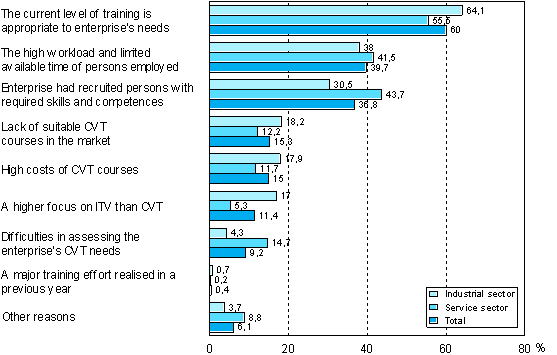6. Obstacles of training
Just under one-quarter of enterprises did not organise any personnel training in 2005. The enterprises that had not organised training (course-format or other training) were asked to name their three most important reasons for not having organised training. The multiple choice question with approximately 10 alternatives could also be supplemented with an own reason.
A total of 60 per cent of the enterprises that had not provided training (N=3711) gave as the main reason for not having done so the fact that their personnel’s existing competence and qualifications met their present needs.
Personnel’s high workload and lack of time, and the fact that they had already recruited persons with the required competence and qualifications were given as the reasons by approximately 40 per cent of the respondent enterprises.
Figure 10. Most important reasons why enterprise did not organise training in 2005 (Enterprises not having organised training) 1)

1) Enterprises could name at most three reasons why they had not organised personnel training in 2005. Therefore, the shares do not sum up to one hundred.
The same three main reasons as in Finland, although not with the same shares, also emerged as the most important obstacles to training in the EU Countries (EU27). At the EU level, ”Personnel’s competence and qualifications meet enterprise’s present needs” was the most often quoted reason, given by three-quarters of enterprises. Good one-half of enterprises reported as the reason the fact that it already recruited persons with the required competence and qualifications and approximately one-third blamed the personnel’s high workload and lack of time.
The responses of the manufacturing and services sectors deviated from each other in some respects. Around 40 per cent of enterprises in the services sector said that they did not organise training because their primary strategy was to recruit persons who already had the required competence or qualifications. In the manufacturing sector the respective proportion was approximately 13 percentage points smaller. Respectively, the services sector saw assessment of the enterprise’s personnel training needs as a greater obstacle to the organisation of training (15%) than the manufacturing sector (4%).
The manufacturing sector thought more often than the services sector that the reason for not organising training was because basic vocational education was viewed as more important than personnel training (manufacturing 17%, services 5%).
Especially in financing and insurance activities it was felt very strongly that the personnel’s existing competence and qualifications met the enterprise’s present needs because 100 per cent of the enterprises that had not organised training gave this as the reason.
Small enterprises of 10-49 employees felt clearly most strongly that the personnel’s existing competence and qualifications met their present needs because good 60 per cent of this group mentioned this as the reason for not having organised training. Only good one-third of enterprises larger than this quoted this as an obstacle.
Source: CVTS, Continuing vocational training survey, Statistics Finland
Inquiries: Hannu Virtanen 09–1734 2514, Tarja Seppänen 09–1734 3220
Director in charge: Riitta Harala
Updated 8.5.2009
Official Statistics of Finland (OSF):
CVTS, Continuing vocational training [e-publication].
ISSN=1798-0003. Participation in course-format training 2005,
6. Obstacles of training
. Helsinki: Statistics Finland [referred: 17.12.2025].
Access method: http://stat.fi/til/cvts/2005/02/cvts_2005_02_2009-05-08_kat_006_en.html

